Introduction
With the Apple iPhone 12 Pro Max, our collection is finally complete. It is the biggest, heaviest, most powerful, and most feature-rich iPhone Apple has made so far, and that's enough to make it the best-seller it was designed to become.
 iPhone 12 mini, iPhone 12, iPhone 12 Pro Max and iPhone 12 Pro
iPhone 12 mini, iPhone 12, iPhone 12 Pro Max and iPhone 12 Pro
The new iPhone 12 Pro Max is the only member of Series 12 to pack the new and improved triple-camera on the back. This might be even enough to entice users who may not even be after the Max size. That is how a proper upgrade should be done - by updating every aspect possible, not just the design.
The iPhone 12 Pro's Max denomination isn't standing just for maximum size, but for the complete set of new features. The biggest iPhone to date enjoys the most premium and durable design Apple has ever made, the most powerful chip with 5G support, the latest Apple camera, the LiDAR scanner, the largest speakers, the beefiest battery, and, of course, MagSafe support.
 Apple iPhone 12 family
Apple iPhone 12 family
This Max version could have been even better with a 120Hz display, but, alas, this feature didn't make the cut on Series 12. Maybe next year, who knows, but today even the most expensive iPhone can't show more than 60fps on its screen.
We know you are eager to see the Pro Max's battery life and camera performance, but first things first. Let's take a closer look through its specs, shall we?
Apple iPhone 12 Pro Max specs:
- Body: Stainless-steel frame with glossy finish, Ceramic Shield front with oleophobic coating, Glass back with frosted finish, IP68 certified for water and dust resistance. Silver, Graphite, Gold, Pacific Blue color options. 160.8 x 78.1 x 7.4 mm, 228 g.
- Display: 6.7" Retina XDR OLED screen of 1,284 x 2,778 px resolution, 458ppi, 800 nits, 120Hz touch sensing. HDR10, Dolby Vision support, wide color gamut. True Tone.
- Chipset: Apple A14 Bionic chip (5nm) - Hexa-core (2x3.1 GHz Firestorm + 4x1.8 GHz Icestorm with 3.1GHz Turboboost) Apple CPU, four-core Apple GPU, 16-core Apple NPU 4-gen
- Memory: 6GB of RAM; 128/256/512GB of internal storage
- Rear camera: Triple 12MP camera: Primary - 1.7µm pixels, 26mm, f/1.6, IBIS, Dual Pixel AF; Ultrawide-angle - 1.0µm pixels, 13mm, f/2.4, 120-degree field of view; Telephoto -- 1.0µm pixels, 65mm, f/2.2, OIS, 2.5x optical zoom; dual-LED flash with slow sync. Night Mode, Smart HDR 3, Deep Fusion.
- Video recording: 2160p@60/30fps, 1080p@30/60/120/240fps video recording with wider dynamic range and spatial sound, OIS + EIS, Dolby Vision capturing.
- Front camera: Dual camera - 23mm 12MP f/2.2 front-facing camera with HDR mode + 3D TOF camera; Night Mode, Smart HDR 3, Deep Fusion. 2160p@60/30fps, 1080p@30/60/120fps video recording with wider dynamic range and spatial sound, EIS.
- Connectivity: Dual SIM, 5G, 4G; Wi-Fi a/b/g/n/ac/6; Bluetooth 5.0; Lightning port; GPS with A-GPS, GLONASS, GALILEO, QZSS; NFC; Apple U1 chip ultrawideband
- Battery: 3,687 mAh battery, 20W fast charging, 15 Qi wireless charging (MagSafe)
- Misc: Face ID through dedicated TrueDepth camera, stereo speakers, Taptic Engine
The iPhone 12 Pro Max is an upscaled version of the iPhone 12 Pro with a bigger display and battery. It also features a larger 12MP sensor for its primary camera with the industry's first sensor-shift image stabilization. Finally, its telephoto camera has an even longer-range lens now - 65mm f/2.2 for 2.5x optical zoom. Nice!
Finally, even if the iPhone 12 Pro Max is one of the most expensive phones today, just like the rest of the iPhone 12's, it also comes accessory-free thanks to Apple's latest controversial endeavor to save the planet.
Unboxing the iPhone 12 Pro Max
The Apple iPhone 12 Pro Max comes within a thin and lightweight box that contains the phone and a USB-C-to-Lightning cable.

There is no charger or EarPods inside, but you will find a SIM ejection pin and a lonely Apple sticker if you dig deeper. You better hold on to that metal pin, as it might disappear next year, too.
Design, build, handling
Meet the biggest and heaviest phone Apple has made so far - the iPhone 12 Pro Max. But while its size might be extra-large, the 12 Pro Max is in no way bulky. The new design and 7mm slim profile make this huge iPhone one exquisite-looking piece of technology that's a real pleasure to use and carry around.
 Apple iPhone 12 series
Apple iPhone 12 series
The iPhone 12 Pro Max shares design with the rest of Generation 12. In fact, it's a stretched version of the regular Pro, through and through.
 iPhone 12 Pro Max and iPhone 12 mini
iPhone 12 Pro Max and iPhone 12 mini
The 12 Pro Max is big alright, bigger than we've imagined. But give it an hour or so, and you may find yourself getting used to it. Or not. That's why we advise you to go and experience it in a shop before you are fully committed to ordering one.
The Apple iPhone 12 Pro Max adopts the iPhone 5 reimagined design, complete with all premium goodies Apple has prepared for this generation. It has the Ceramic Shield at the front, the polished stainless-steel frame on the sides, and the tough Gorilla Glass on the back. The 12 Pro Max is as waterproofed as the rest of the iPhone 12 bunch - meaning IP68-rated for dust and up to 6m water endurance.
 iPhone 12 Pro Max and iPhone 12 mini
iPhone 12 Pro Max and iPhone 12 mini
The Ceramic Shield is quite the achievement for Apple and Corning, and it proved to be quite tough to break. Scratches are still a threat but shatter resistance has been much improved. The novel ceramic crystals seem to work as promised, and the countless drop tests on YouTube are the proof.

The premium design continues on the sides where the steel frame looks more like a piece of jewelry rather than a phone. But the good news ends there. This polished piece of metal is incredibly easy to scratch, and it's especially apparent if you have the white model - its silver frame accumulated tiny but visible scratches on the very first day!

Then there is the issue with fingerprints - tons and tons of smudges and unpleasantries stuck on this steel piece forever. Yes, you can clean them, but they'll just come back in mere seconds, so why bother?
The real letdown, though, is the grip provided by this shiny frame, or rather, the lack of it. The steel frame is so glossy and slippery that it's nearly impossible to pick up the iPhone 12 Pro Max from your desk without risking dropping it midway. A case would help, of course, but it will diminish these premium looks. Better safe than sorry, we guess.

Finally, there is the frosted glass back, flat again, which looks nothing short of gorgeous. Whether it's white or blue, gold or graphite, it's an instant eye-grabber. Plus, it feels presently soft on touch, and we just loved running our fingertips across this surface.
 The 12 Pro Max in Pacific Blue and Silver
The 12 Pro Max in Pacific Blue and Silver
Unfortunately, while the rear glass isn't a smudge-fest like the frame, it is just as slippery. The iPhone 12 Pro Max provides an awful grip, and the only thing that kept us from constantly dropping it were the square, though not razor-sharp, edges of the frame.
Now, let's return back to the front and take a look at this gorgeous 6.7" Retina XDR OLED screen. It looks quite sharp and bright, and even the notch looks somewhat smaller within.

That's an illusion, of course, as the cutout has the same size across all notched iPhones. That's because it always houses the same stuff - the 12MP selfie camera, the Face ID tech, the earpiece that doubles as a stereo speaker, and a bunch of sensors.
 Max notch vs. mini notch
Max notch vs. mini notch
The bezels look pretty small, smaller than on the iPhone 11 Pro Max, though this could be another illusion due to the flat frame and straight glass.
The square glossy camera bump accommodates Apple's latest camera advancements - the new 12MP primary camera with the largest sensor on any iPhone to date, the improved 12MP telephoto camera with a new 65mm lens for 2.5x optical zoom, and the enhanced 12MP ultrawide camera with Night Mode. All these shooters can capture Dolby Vision videos, too.

The LiDAR scanner is also around, and it will help with AR apps, Night Mode for Portraits, among many other things.

The camera setup is jutting out a bit, but it's nowhere near the mountains we've seen on some other flagships. As usual, metal rings surround the snappers, while sapphire glass keeps them safe. Just be aware that these sapphire pieces can and will scratch anything delicate you put them on (iPhones included).
Let's take a look at the frame now before it's tarnished.

The volume keys and the silencer are on the left, and they are identical in size across all iPhones. That's why they look so puny on the 12 Pro Max. The SIM slot is also around.

The Side/Power/Lock key is alone on the right side, while the top part has nothing.

The bottom is where you'd find the mouthpiece, the Lightning port, and the other stereo speaker.
The iPhone 12 Pro Max spreads at 160.8 x 78.1 x 7.4 mm - that's 3mm taller than the iPhone 11 Pro Max. It is 2g heavier at 228g making it the heaviest iPhone so far, even if it's just by a hair. In exchange for these extra 3mm and 2 grams, you are getting a larger screen (6.7" vs. 6.5"), more power, and better cameras, so we can't really complain about that.

We really appreciate the beautiful and sturdy assembly of the new iPhone 12 Pro Max - it looks stunning even if it loses some of that charm when it's all smudged.

But the 12 Pro Max is not a phone that's easy to hold and operate, let alone shoot photos or videos on the go - there is just not enough grip for that. A case would help a lot. Even a bumper would do - if only Apple still made those. But having to slap a case on this beauty just to add adequate grip is quite unfortunate.
The largest OLED on an iPhone
All iPhone 12s come with Retina XDR OLED screens, starting with the mini and ending with the Max. This year the Pro Max packs an even bigger display within the same body size as the 11 Pro Max.
So, the iPhone 12 Pro Max employs a 6.7" OLED screen of 1,284 x 2,778 pixels or 458ppi (same sharpness as on 11 Pro Max). It is better-protected courtesy of the new Ceramic Shield, and there are no curved edges whatsoever.

The notch is here to stay, the same size, too. Due to the 12 Pro Max's relatively big screen, though, the cutout looks smaller here.
The Super Retina XDR OLED screen supports HDR10 and Dolby Vision content. Like the iPhones before the 12th generation, this one also comes with True Tone color tuning, Wide Color support, and it has the Haptic Touch feature providing high-quality touch feedback.
The screen works at a 60Hz refresh rate. Unfortunately, the rumored ProMotion feature didn't happen, and even the most expensive iPhones are stuck to a 60Hz refresh rate at the end of 2020. C'mon, Apple! Who decided 5G would be the better feature?!

At least the capacitive layer works with a touch sampling rate of 120Hz, making the iPhone display very responsive.
Apple advertises 800 nits of max brightness on the iPhone 12 Pro display and 600 nits for the iPhone 12's. Both phones offer peak brightness of up to 1,200 nits.
And that's what the 12 Pro Max screen offers - we measured 822 nits of maximum brightness on the iPhone 12 Pro Max with our particular test setup where a truly white pattern covers 75% of the screen.
There is no maximum auto boost on any iPhone, though you'd never miss that with such a bright screen.
The minimum brightness is impressively low at 2 nits.
| Display test | 100% brightness | ||
| Black, |
White, |
||
| 0 | 822 | ∞ | |
| 0 | 820 | ∞ | |
| 0 | 802 | ∞ | |
| 0 | 805 | ∞ | |
| 0 | 639 | ∞ | |
| 0 | 627 | ∞ | |
| 0 | 653 | ∞ | |
| 0 | 497 | ∞ | |
| 0 | 802 | ∞ | |
| 0 | 504 | ∞ | |
| 0 | 1024 | ∞ | |
| 0 | 398 | ∞ | |
| 0 | 894 | ∞ | |
| 0 | 538 | ∞ | |
| 0 | 888 | ∞ | |
| 0 | 336 | ∞ | |
| 0 | 532 | ∞ | |
| 0 | 485 | ∞ | |
| 0 | 807 | ∞ | |
The iPhone 12 Pro Max screen offers excellent color accuracy - we measured an average deltaE of 1.8 and a maximum deviation of 2.5 against sRGB targets. The iPhone 12 Pro Max fully supports DCI-P3, and it automatically switches to this color space when DCI-P3 content is sent to the screen.
As usual, the iPhone 12 Pro Max can maintain such a great color accuracy across all brightness levels, even at the lowest point of 2 nits.
Battery life
The Apple iPhone 12 Pro Max is powered by a 3,678 mAh battery - it's the largest cell among the new iPhones, but about 7% smaller than last year's 11 Pro Max's.
The phone supports fast wired and wireless charging, if you purchase the compatible power adapters, that is.
The iPhone 12 Pro Max did great on our battery test - it lasted north of 14 hours on web browsing, more than 15 hours when playing videos, and you can use it for up to 21 hours of talk time.
The standby performance is about the average for this battery size and modem (Apple uses Qualcomm X55). Mixing these results in our magical formula, we ended up with a pretty good endurance rating of 95 hours for the iPhone 12 Pro Max - about 7% lower than the 102h number we got on the 11 Pro Max but still the best among this year's iPhones.

Our battery tests were automated thanks to SmartViser, using its viSer App. The endurance rating above denotes how long a single battery charge will last you if you use the Apple iPhone 12 Pro Max for an hour each of telephony, web browsing, and video playback daily. We've established this usage pattern so that our battery results are comparable across devices in the most common day-to-day tasks. The battery testing procedure is described in detail in case you're interested in the nitty-gritty. You can check out our complete battery test table, where you can see how all of the smartphones we've tested will compare under your own typical use.
Charging speed
The Apple iPhone 12 Pro Max supports fast battery charging via USB Power Delivery. Apple ships the 12 Pro Max without a charger, but you can opt for Apple's 20W PD charger or any other 20W+ USB-PD power adapter.

If you recharge your dead iPhone 12 Pro Max with Apple's 20W charger, it will refill 55% of its battery in 30 mins and 86% in 60 mins.
30min charging test (from 0%)
- Xiaomi Mi 10 Ultra
100% - OnePlus 8T
94% - Huawei Mate 40 Pro (66W)
87% - Samsung Galaxy S20 Ultra
64% - Apple iPhone 12 mini
60% - Apple iPhone 12 Pro
59% - Apple iPhone 11 Pro
58% - Apple iPhone 12 Pro Max
55% - Apple iPhone 11 (18W)
55% - Apple iPhone 11 Pro Max
50% - Samsung Galaxy Note20 Ultra 5G
43% - Apple iPhone 12 mini (MagSafe)
30% - Apple iPhone 12 Pro Max (MagSafe)
28% - Apple iPhone XS
22% - Apple iPhone 11 (5W)
18% - Apple iPhone XS Max
18%
A full charge with that 20W adapter takes 89 mins. We admire Apple's consistency with the charging speeds - no matter the battery capacity - we'd get a similar charging level for 30 mins, and a full charge will always take about 90 mins.
Time to full charge (from 0%)
- Xiaomi Mi 10 Ultra
0:27h - OnePlus 8T
0:36h - Huawei Mate 40 Pro (66W)
0:45h - Samsung Galaxy S20 Ultra
0:58h - Samsung Galaxy Note20 Ultra 5G
1:23h - Apple iPhone 12 mini
1:29h - Apple iPhone 12 Pro
1:30h - Apple iPhone 12 Pro Max
1:32h - Apple iPhone 11 Pro
1:50h - Apple iPhone 11 Pro Max
2:00h - Apple iPhone 11 (5W)
4:00h
The iPhone 12 Pro Max supports up to 15W 'fast' wireless charging but only when using MagSafe chargers. Other makers already offer north of 40W wireless charging, but we guess 15W is fast in Apple's terms. And if you opt for a regular Qi-compatible charger, you'll be limited to 5W-8W or so.
We tested the iPhone 12 Pro Max with Apple's own MagSafe wireless charger, of course. If the phone is dead - it will take about 5 minutes to wake it up. And then the MagSafe charger would refill 28% of the battery in half an hour. A full charge requires more than 3 hours.
Given the sluggish speed and unreliable charging performance, we don't see the point of upgrading to this €50 MagSafe wireless charger just yet.
Speakers
The iPhone 12 Pro Max, just like the rest of the iPhone 12s, packs a hybrid stereo speaker setup with spatial audio support. There is one speaker at the bottom and another one inside the screen notch, which also doubles as an earpiece.
The stereo output is reasonably balanced even if the earpiece seems a bit quieter and bass-less if the bottom is muted.

The iPhone 12 Pro Max scored a Very Good mark in our loudness test, and it is on par with the new iPhone 12's and the 11 Pro Max. The audio quality is the best among the new iPhones - the 12 Pro Max has the deepest bass and the richest mid-tones, while the high-notes are well presented as good as always.
Long story short, even if the iPhone 12 Pro Max has similar loudness as the rest of Series 12, it offers the best speakers on an iPhone so far and one of the best audio setups we've experienced on a smartphone to date.
Use the Playback controls to listen to the phone sample recordings (best use headphones). We measure the average loudness of the speakers in LUFS. A lower absolute value means a louder sound. A look at the frequency response chart will tell you how far off the ideal "0db" flat line is the reproduction of the bass, treble, and mid frequencies. You can add more phones to compare how they differ. The scores and ratings are not comparable with our older loudspeaker test. Learn more about how we test here.
Apple iOS 14 on the iPhone 12 Pro Max
All new iPhones come with the iOS 14.1 pre-installed, but the iOS 14.2 will be already waiting for you in Settings. It's a minor update over the iOS 14.1 containing mostly bug fixes, 8 new wallpapers, and over 100 new emojis.
Let's take a closer look at iOS 14 on the iPhone 12 Pro Max now.

Its focus falls on the new widgets and App Library, which will improve your experience should you decide to use them. It's nice to see Apple has decided to make new features as optional as possible, instead of forcing them on you right away. The rest of iOS remains mostly unchanged since iOS 13, with some minor UI improvements across different system apps. Some new apps and features are available, too.

The lockscreen on iOS 14 remains intact - it's one with the Notification Center and houses your notifications (privacy options are available), plus shortcuts for the torch and the camera. You can get past it via Face ID or PIN if you've opted for secure unlock.
Your apps usually populate the homescreen(s) and widgets - the leftmost Today page. Now there is also a rightmost page - the App Library.
A new option allows you to hide specific homescreens - you may have a page that's full of games and hide when at work or hide the two pages of work apps when on vacation. You can't opt-out of Today and App Library, though.






Lockscreen • Homescreen • Homescreen • Today • App Library • Hide homescreens
You can continue to use iOS 14 the old way if you like and completely ignore the App Library. There is no option to disable the App Library entirely, though.
The new Widgets can be placed on any of the homescreens and the Today page, and they can coexist with app icons. There are three widget sizes supported by iOS 14 - 2x2, 4x2, and 4x4.
You can stack widgets of the same size on top of one another. Once you have a stack, you can either have the OS automatically choose which is the most relevant widget to surface to the top of the stack automatically. You can also flip through the stack manually by swiping up or down until you find the widget you need. We love this idea of stacked widgets - it's a real space saver - especially if you combine a frequently used widget at the top with less frequently used ones in the stack below it.





Widgets • Widgets • Widgets • Stacked Widgets • Settings
The App Library is an app drawer, which is always your rightmost homescreen pane. Apps are added automatically to the App Library upon installation. The sorting is also an automatic process, and you can't edit the categories or move apps to other categories. The app sorting depends on the App Store tags the developer has used upon uploading the apps.
The App Library has three settings only - Add new apps to Homescreen and App Library, Add to App Library only, and Show Notification Badges in App Library. That's it.

The App Library is where you will ditch your least used apps to die. (With Thanos's voice) It's inevitable.
We bet the Today page will slowly go away, but for now, it is only for widgets. You put the same widgets and stacks you can on your homescreen(s). Here you can also use the old third-party widgets that haven't been optimized yet for iOS 14. The old widgets come right after the new one, should you choose to use some new ones.
In time, we guess all developers will update their widgets to support iOS 14, and that will be the death of Today as we know it.
The Notification Center is summoned with a swipe from the left horn or the notch. The pane was unified with the lockscreen in iOS 11, and that's why you can have different wallpapers on your homescreen and notification center.
The Control Center, which has customizable and (some) expandable toggles, is called with a swipe from the right horn. You can use haptic touch to access additional controls. And the battery percentage is also here.




Today • Today settings • Notification Center • Control Center
The navigation gestures stay the same as they were on the iPhone X. Swipe upwards from the bottom line to close an app, swipe and stop midway for task switcher, swipe from the side of the screen for back and forward. You can also swipe on the line left or right to switch to your recently used apps instantaneously.
The Back Tap is a new accessibility shortcut. It recognizes double and triple tap on the phone's back, and you can assign whatever you like. We chose 'Take a screenshot' and 'Control Center,' but it is really up to you. Overall, it has to be one of our favorite features in iOS14.






Gestures • Task Switcher • Moving between apps • Back • Closing an app • Back Tap
The iPhone 12 Pro Max has exclusive support for enhanced landscape view in some system apps. The Settings app looks different in landscape orientation; the Mail, and Messages, Safari as well.




Landscape view in different apps
There is a system-wide Dark Mode. You can enable it manually or schedule it from within Display Settings, and it switches to dark all-white backgrounds across iOS. The Dark Mode affects all system apps, but also apps that rely on system backgrounds. You can also check the option to darken the homescreen wallpaper when in Dark Mode.
The App Clips service is a major part of iOS 14 even though it is yet to become widespread. An App Clip is a pop-up window where you can use a small part of an app that you don't have installed on your phone without going to the App Store and downloading it. Basically, iOS 14 downloads this "clip" for you in real-time, you use the function, and then it goes away.
For example - you browse burgers in your browser, you see a place with nice burgers, you tap on a burger you want to order. A small pop-up window appears of, say, Foodpanda's app where you can order the said burger without installing their app and making a proper registration. The same goes for taxis, bike, or scooter rentals, among others.

Siri - Apple's digital assistant - is used by 400+ million people monthly. You summon it by holding the 'side' key (the Power key). You can do all sorts of things with Siri - from questions and translations through setting up reminders and sending replies to asking for reservations or tickets, directions, and whatnot.
Siri Shortcuts are available within a standalone app. You can assign a shortcut to so many things that it will take many pages to describe them. You can script almost anything available within iOS itself, a lot of stuff from within the system apps, and some advanced actions from any well-known apps such as YouTube or Facebook.
Another new feature in iOS 14 is the more compact Siri interface. Upon summoning Siri, you will see a small ball around the bottom, and your answer will be provided in a small pop-up window. This way, you can still see what's happening in your active app.
Speaking about compact interfaces, Siri isn't the only app getting such refresh. The Phone app is still the same, but receiving a call while your phone is unlocked has become a much more unintrusive thing with the new compact UI. Instead of pausing everything you were doing and throwing you the black call screen, now you get a small pop-up with Green and Red receivers and the caller ID.
PiP or Picture-in-Picture mode is a very welcome and long-overdue feature in iOS. It does precisely what the name suggests - minimizes your currently playing video within a hovering pop-up over the iOS UI or other apps.
PiP is supported in Apple TV, Podcasts, Safari, FaceTime, iTunes, Home, YouTube, and any other third-party app that chooses to add support for it.
Now, can we get PiP for Maps next, Apple? Pretty please?





The new Siri UI • Compact Siri answer • Compact phone call • Picture in Picture • PiP
The multimedia is handled by Apple's default apps - Photos, Music, TV - and they are mostly unchanged since their iOS 13 versions.
The Photos tab has four different views - Years, Months, Days, and All Photos. Days, Months, and Years tabs use what the AI considers as best pictures at a glance, and this way, all the clutter gets filtered - you won't see screenshots, notes, or even duplicates. When you scroll through your images in these three categories, all live photos and videos will play automatically (muted). Also, your best photos or videos will show in bigger thumbnails.
AI-powered search option and powerful photo and video edit modes are available, as usual.
The Apple TV app is part of iOS 14, and it is your default video player for locally stored movies and shows you've added via iTunes. This is also the digital store for movies and TV shows, but it is also where you find the Apple TV+ streaming service.
Music has a new homescreen icon. It is the default player, and it relies heavily on Apple Music. But even if you decide not to use the streaming service, it can still do an excellent job if you have a few minutes to add your songs via iTunes. Realistically, adding music tracks via iTunes requires as few clicks as it would take to copy them via Windows Explorer, so there is no overhead. The requirement to download and install iTunes in the first place, however, can be off-putting to Windows PC users.
Books are here for your documents, PDFS, and eBooks. Stocks and News are onboard. Safari is your default web browser, and it has a Download manager and some enhanced privacy options we will talk about in a minute.
Apple Maps will be bringing its new, enhanced mapping solution to the UK, Ireland, and Canada "later this year." It adds cycling directions, complete with elevation info, and a new "avoid stairs" option for New York, LA, San Francisco, Beijing, and Shanghai.
The new EV routing will factor in necessary charging stops along the way.
Guides let you discover restaurants, popular attractions and explore recommendations from "respected brands."
The maps also show known speed cameras and red-light cameras.
Some of the new Privacy features include options to change default browser and mail client, Safari's Privacy report about website trackers, the option to report approximate instead of precise location, and also the green and orange indicators for camera or microphone in use.





Default browser • Privacy report • Approximate location • Mic indicator • Camera indicator
Finally, Apple Pay is on board, of course, and Sign-in with Apple is pushed everywhere. You can use this to quickly sign into apps with your Apple account, authenticating with FaceID and with two-factor authentication included. Apple will send the app a unique random ID. If an app demands your email address, you can choose to give it your actual email or a random one automatically created by Apple for you with built-in forwarding.
LiDAR capabilities
Apple made a big deal of the new LiDAR scanner. The miniaturization of the LiDAR (Light Radar, Light Detection and Ranging, and know also known as Laser Imaging, Detection and Ranging) technology is one of Apple's more prominent achievements, and after the iPad Pro, it now premieres on the iPhone 12 Pro and Pro Max.

The LiDAR scanner measures distances by firing laser beams and measuring their reflections with a dedicated sensor. This way, the phone can make a super accurate 3D representation of an object and later place it virtually anywhere. Thinking of new furniture? This will be perfect. Want to compare the size of objects you can't put next to each other - LiDAR will help.

The LiDAR scanner is also very accurate at measuring distances, and you can use it just for that - like a fancy digital tapeline. Or you can set a distance and see virtual walls in real-time at the predefined distance. Professionals such as interior designers may find the LiDAR scanner a handy tool.
Thanks to the powerful AR capabilities that also come as a bonus with LiDAR, you can also have an amazing AR experience with compatible apps and games.
Another benefit of this technology is the speedier (and more accurate) focus in low light. And because the sensor doesn't care about light conditions and can work even in pitch dark room, you can now shoot low-light portraits for the first time with great subject separation and blur.

Long story short - you can use LiDAR-compatible apps (such as 3D Scanner App) to scan and place objects wherever you like, export such objects to use in your projects, and even measure distances. Of course, you can also enjoy the boosted AR experience in various games.
Performance and benchmarks
The Apple A14 Bionic chip powers the entire iPhone 12 generation. It is the first commercially available 5nm chipset in the world, packing 11.8 billion transistors or 40% more than A13.
The A14 chip has a six-core processor, just like the last Apple chips. It has 2 big Firestorm cores clocked at 3.1GHz and 4 small Icestorm cores working at 1.8GHz with TurboBoost capability to go to 3.1GHz when necessary.
There is also an updated 4-core Apple GPU, which should offer some increase in performance over last year's iPhones.
Then there is the new 16-core NPU for machine learning that brings a 70% increase in AI performance.
The iPhone 12 Pro Max has 6GB of RAM, while the non-Pro models come with 4GB of RAM.
The Apple A14 Bionic also comes with Qualcomm's X55 5G modem, and that's why the entire iPhone 12 lineup supports 5G connectivity.
The new A14 Bionic chip and its ISP are also at the heart of the improved camera quality - the Smart HDR 3, Deep Fusion, Night Mode, Dolby Vision recording, and more - these new features are all possible thanks to the sheer power of the A14.

The iPhone 12 phones are the fastest iPhones so far, of course. The Apple A14 has the most powerful processor to date, as usual, and is about 20% faster than the A13-powered iPhone 11 series.
GeekBench 5 (multi-core)
Higher is better
- Apple iPhone 12 Pro Max
4240 - Apple iPhone 12 mini
4174 - Apple iPhone 12
4067 - Apple iPhone 12 Pro
4056 - Apple iPhone 11 Pro Max
3503 - Apple iPhone 11 Pro
3466 - OnePlus 8 Pro (120Hz, 1440p)
3374 - Apple iPhone SE (2020)
3237 - Samsung Galaxy Note20 Ultra 5G
2603
GeekBench 5 (single-core)
Higher is better
- Apple iPhone 12 Pro
1611 - Apple iPhone 12 Pro Max
1606 - Apple iPhone 12
1605 - Apple iPhone 12 mini
1599 - Apple iPhone SE (2020)
1334 - Apple iPhone 11 Pro
1333 - Apple iPhone 11 Pro Max
1332 - OnePlus 8 Pro (120Hz, 1440p)
902 - Samsung Galaxy Note20 Ultra 5G
880
The improved GPU indeed offers more raw power, though it's about 10% increase over the A13's.
GFX Manhattan ES 3.1 (offscreen 1080p)
Higher is better
- Apple iPhone 12 Pro Max
135 - Apple iPhone 12
132 - Apple iPhone 12 Pro
132 - Apple iPhone 12 mini
131 - Apple iPhone 11
121 - Apple iPhone 11 Pro Max
120 - Apple iPhone 11 Pro
118 - Apple iPhone XS Max
99 - Apple iPhone XS
98 - Apple iPhone X
65
GFX Car Chase ES 3.1 (onscreen)
Higher is better
- Apple iPhone 12 mini
60 - Apple iPhone 11
60 - Apple iPhone 12
58 - Apple iPhone 12 Pro
58 - Apple iPhone 11 Pro Max
57 - Apple iPhone 11 Pro
57 - Apple iPhone 12 Pro Max
55 - Apple iPhone XS
47 - Apple iPhone XS Max
47 - Apple iPhone X
28
Of course, the latest iPhone is doing great on the AnTuTu test.
AnTuTu 8
Higher is better
- Apple iPhone 12 Pro Max
638584 - Apple iPhone 12 Pro
596244 - Apple iPhone 12 mini
589616 - Apple iPhone 12
579048 - Apple iPhone 11 Pro Max
536883 - Apple iPhone SE (2020)
462253
The Apple A14 Bionic chip, even if it makes the iPhone 12 Pro Max the fastest smartphone on the planet, will not be among the top reasons to upgrade on Series 12. Performance has always been top-notch on the iPhones, even if it's a four-year-old model. It's the A14 chip's new features that matter - such as the improved machine learning and the new ISP, which take computational photography on the next level.
One thing we can definitely say is that judging by those high frame rates achieved on the offscreen benchmarks, the iPhones' 120Hz screens are already a few years overdue.
Gaming is great on the iPhones, though it turns out the iPhone 12 Pro Max provides a better cooling system and thus less throttling over long gaming sessions or benchmarks. Just like the iPhone 12 and 12 mini, the Pro Max becomes very warm around its frame and one specific spot on the back, it doesn't overheat and throttle even under the long stress tests we ran.
The iPhone 12 Pro Max has a stability score of 89.1% on the 3D Mark Wild Life Stress Test, which runs 20 loops of the Wild Life graphic test. The iPhone 12 Pro has the same score (90%).

The iPhone 12 achieves 84% stability on a newly configured phone, but it drops to 75% when we populated it with apps such as Facebook, Skype, Whatsapp, Messenger, Bluetooth accessories, etc. The iPhone 12 mini is much worse - it skips a whole loop as it stops everything for a minute to prevent overheating but then it continues rather normally.
It seems the iPhone 12 Pro Max is well-suited for gaming with better cooling and stability than the iPhone 12 and 12 mini. It does get hot in stress tests, but elsewhere (games or apps) we couldn't warm it that much.
Exclusive camera with pro features
The improved camera hardware Apple introduced with iPhone Series 12 turned out to be exclusive to the iPhone 12 Pro Max. We've talked about that through our iPhone 12 reviews and today we are finally going to find out if this Pro Max camera is praiseworthy.

The iPhone 12 Pro Max offers a triple 12MP camera on its back, just like the regular iPhone 12 Pro and 11 Pro, but the hardware is different. The LiDAR scanner assists the autofocus and helps take portraits with realistic defocused background.
The selfie camera is the identical across all four iPhone 12s - it's a 12MP snapper with fixed focus. The structured-light 3D scanner for Face ID assists the Portrait mode in selfies.

The primary camera features the first major upgrade in a long time - it still uses a 12MP sensor but now it is 47% larger than the iPhone 11 Pro and 12 Pro's with bigger 1.7µm sensor pixels and will capture more light at night. The lens is still 26mm f/1.6, but it is not optically stabilized. Instead, this camera uses sensor-shift stabilization, meaning it's the sensor that is stabilized in real-time and not the lens.
The sensor-shift stabilization, also known as IBIS or In-Body Image Stabilization, moves the entire sensor to counter shake instead of the optics lens. The more space the sensor is allowed to move within its frame - the better the stabilization. And since the sensor is just a single piece on a flat surface - adjustments happen much faster than on a seven-piece optical lens assembly. To be specific, the sensor-shift stabilization on the iPhone 12 Pro Max allows for up to 5,000 adjustments per second.
The new IBIS should allow for better video stabilization - unlike OIS, IBIS also counters rotational shake in addition to the regular X and Y axis movements. It should also allow for better low-light photos, especially such without Night Mode or similar artificial adjustments. The IBIS allows for longer shutter speeds without a tripod - this plus the bright f/1.6 lens and the new large sensor should do for some great and natural night photos. The best results should be seen in RAW photos, of course, where no Smart HDR or Deep Fusion is involved. The iPhone 12 Pro Max can shoot RAW, in fact, Apple has introduced an advanced ProRAW format, but this will be added via a firmware update later on.
The ultrawide camera uses a 12MP imager, too, with smaller 1.0µm pixels and 13mm f/2.4 lens. The focus is fixed, and there is no stabilization whatsoever. This camera, like the main one, supports Night Mode. There are no exclusive features on the ultrawide shooter for the 12 Pro Max - it is the same cam across all four iPhone 12 devices.
But the telephoto snapper on the Pro Max has been improved with longer-range zoom lens - it can now offer 2.5x optical zoom. Yes, Huawei will have a field day with that, but Apple considers this a portrait camera and you can't shoot portraits with a 130mm or so lens, can you?
Anyway, the third 12MP camera also uses a rather small sensor with 1.0µm pixels. The lens is now 65mm f/2.2, optically stabilized. This camera supports PDAF, but what it cannot do is Night Mode. The Portrait Night Mode is available only on the main camera.
The LiDAR scanner assists the main and portrait cameras with detailed depth maps for portraits, and faster autofocus in low-light conditions. One might say this is the iPhone's fourth camera.
Finally, the selfie camera uses a 12MP sensor with 1.0µm pixels and a 23mm f/2.2 lens. The focus is once again fixed. When using portrait mode on this camera, it captures a depth map with the structured-light 3D scanner and we've seen it do some impressive portraits.
All cameras support up to 4K@60fps video capturing with Cinematic Stabilization (EIS, EIS+IBIS/OIS) and Expanded Dynamic Range. Dolby Vision HDR capturing is possible on all cameras at all framerates.
Camera app and features
The viewfinder of the default camera app is mostly unchanged since iOS 13 and the iPhone 11. You can see outside of the viewfinder thanks to the precise calibration of the cameras that allows seeing what will be left outside the frame in real-time. This really makes for a more immersive camera experience, and if Photo/Video Capture Outside the Frame is enabled, then you can later expand your footage from the Photos app if something important was cut.
The new Apple image processing that's possible thanks to the new A14 chip includes Smart HDR 3, Night Mode (excluding telephoto), and Deep Fusion.

The Smart HDR 3 name speaks for itself - it's an improved HDR processing algorithm used in scenes with challenging light conditions.
The Night Mode icon pops up automatically when a low-light occasion presents itself, and it will take a pseudo-long-exposure shot, handheld of course. You will see the seconds suggested next to the Night Mode icon, but you can change the exposure time or altogether disable it with a tap. Usually, the phone picks exposure times of 1, maximum 2 seconds, but sometimes it will allow you to go for up to 10 or more seconds depending on the available light. You can use this mode on all cameras but the telephoto. The Night Mode Portraits, exclusive to iPhone 12 Pro and Pro Max, are shot with the main camera.
Deep Fusion is used when light conditions aren't ideal, say, indoors. It triggers instead of Smart HDR and Night Mode. Deep Fusion uses four frames before you hit the shutter, four more once you do, and one long exposure shot. The 16-core Neural engine will select the best frames and create a high-quality HDR photo that is very detailed, sharp, and natural-looking. The Neural processor's machine learning process analyzes the image being taken and processes them differently depending on what's in the frame - say, sky, foliage, or skin tones. Meanwhile, structure and color tones are based on ratios obtained by the Neural unit on the A14 CPU.
As usual, all cameras talk to each other, so they already know the correct exposure and tone mapping settings when you switch between them. This applies for both stills and videos.
The camera interface is mostly unchanged. You swipe between modes and have a couple of settings you can uncover with an upward swipe - flash, night mode, live photo, photo aspect, exposure compensation, and filters. In video mode, you can change the resolution and frame rate straight from the viewfinder.
The iPhone 12 Pro Max will support shooting in ProRAW format, but this will be added via a firmware update later on.
Some of the more advanced settings are hidden withing Settings -> Camera.
Photo quality
The main camera saves 12MP photos and those are pretty good. If you've expected these to be different from the iPhone 12 and 12 Pro - we'd have to disappoint you. These seems to be rather identical to the daylight images saved by the rest of the iPhone 12s and the 20% larger sensor pixels won't give you more detail or better foliage.
Let's take a closer look. The images indeed do look nice with high contrast, low noise, accurate white balance and realistic colors. The dynamic range isn't over the top and Apple has a more natural approach to it.
There is more than enough detail, too, but even with the new large sensor intricate objects remain a difficulty and aren't processed properly - they are either smeared or deformed. The grass is smudgy and then over-sharpened to mask that, bushes as well, windows' blinds aren't ideal, and people are hit and miss.
Then there is the shallow depth of field courtesy of the new f/1.6 lens, but that's not an issue per se. Until it is - if you want to shoot some closeups, you may want to move a bit farther or parts of the subjects will be blurred.
Overall, those are good photos, but Apple needs to tune its processing better. Maybe less sharpening and more efforts on high frequency detail instead of HDR would help.
The 12MP ultrawide photos are excellent. They are impressively wide and yet offer quite proficient distortion correction that strengthens warped objects and keeps fine detail mostly intact. Nice! You can turn the automatic correction off if you prefer even wider field of view at the expense of some warping in the corners.
The captured detail is good at the center and average around the edges. The foliage is a challenge for the processing, again, and you can spot some noise leftovers mostly in areas of uniform colors. Other than that, the photos offer great contrast, accurate white balance and color presentation, and reasonably high dynamic range.
The 12MP 2.5x zoomed photos from the tele camera are superb - the resolved detail is a lot even with the occasional hit and miss grass or tree - the defects are not as prominent as on photos from the main camera.
So, in addition to the excellent detail, we also observed high contrast and once again - spot on white balance and colors. We appreciate the well-tuned HDR processing and the rather balanced dynamic range across all snappers, including the telephoto.
Moving on to some nighttime images. Apple's Night Mode triggers automatically in low-light scenes but the first thing we noticed that's different from the rest of the iPhones we've reviewed is that the Night Mode chooses faster exposure times (1s instead of 2s or 3s) or sometimes it doesn't even pop-up.
You can't really opt-out of it unless you manually force it off each time it pops up. And there is no need to pay attention to what is or isn't happening. Sure, you can turn this feature off each time or correct the suggested exposure time, but we advise using it as is. It doesn't always pop-up, but even when it does - the Night Mode opts for 1s exposure and the image is saved instantly. Since the exposure time is 1s instead of 2-3-4s, you won't have (that much) blurred moving objects like cars or people.
The first set of photos we offer you below were shot on Auto and for most, if not all of them, the algorithm chose 1s exposure time. The images are admirable - detailed and low on noise, with perfectly balanced exposure and preserved color saturation.
The highlights are handled very well, too, while the shadows aren't brightened unnaturally and remain rather realistic and as seen on the spot. Apple aims to take a good night photo instead of turning the night into a day and we can get behind that.







Main camera, 12MP
If you intentionally disable the Night Mode when it was suggested, the 12MP photos will be saved with lower sharpness and contrast, and the colors may look a bit desaturated. The noise is still handled well, but the photos are darker and with more clipped highlights.
Still, even without Night Mode, the images do look good and we are sure if you have the patience and skills to shoot and edit in RAW, you will get some stunning shots at night with this camera. RAW will always allow you to extract better images than any artificial algorithm, let alone an overprocessed fest like the combination of Night Mode, Smart HDR and Deep Fusion.
The ultrawide camera on the iPhone 12 Pro Max offers Night Mode, as expected, and it always fires unless disabled. The 12MP ultrawide photos shot with Night Mode are okay - they have balanced exposure and well-restored highlights, offer a lot more detail than the regular ones even if they remain soft, and the colors are mostly preserved. They are far from great, but quite usable, especially for sharing in chats or social networks where no one will be pixel peeping.
We don't recommend turning off the Night Mode for the ultrawide images. You'd end up with dark photos with poor detail, washed-out colors, and a ton of noise.










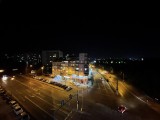

Ultrawide camera (NM OFF), 12MP
The 12MP tele camera sometimes works at night and that depends on the available light. If the luminance goes beyond some fixed point, the 12 Pro Max uses its primary camera and digitally zooms instead.
Night Mode isn't available on the zoom camera. If you see the Night Mode icon appear on your viewfinder while shooting in 2.5X zoom, this means the iPhone has switched to its primary camera and will be digitally zooming instead. The Night Mode pop-up on the telephoto camera is the tell of what type of zoom is going to be used - digital or optical.
So, the 12MP native 2.5x zoomed photos are very good. Sure, they could be a bit dark at times, but they offer a lot of fine detail and good contrast. The noise is handled very well and sometimes it can be completely eliminated. Finally, the colors are kept natural and while some desaturation does happen, it's rather rare.
We think given the right subject, you all will be happy with the telephoto images at nighttime.
We didn't really miss the Night Mode on the tele camera, but we have to wonder why Apple didn't allow it here, too. Maybe it will premiere on the iPhone 12S, who knows!
And here are a bunch of 2.5x digitally zoomed photos, which look good on the iPhone's screen, but unpleasant elsewhere.
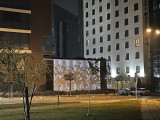

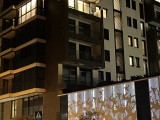

2.5X digitally zoomed photos, 12MP
You can also look at our photo compare tool and see how the Apple iPhone 12 mini stands against some of its rivals.



Apple iPhone 12 Pro Max vs. Apple iPhone 11 Pro Max and the Apple iPhone 11 XS Max in our Photo compare tool
Portrait quality
The Portraits on the Apple iPhone 12 Pro Max are shot with the telephoto camera by default, but you can switch to the main snapper any time if you need a wider photo. The LiDAR Scanner is of a big help here as it creates an incredibly detailed depth map for the camera to use, and subject separation is supposed to be near perfect.

Also, thanks to the LiDAR being independent of the available light, the iPhone 12 Pro Max can again do Night Mode portraits. But one thing should be very clear - Night Mode for portraits works only on the main camera. If you switch to Portrait mode - it always defaults on 2.5x zoom - and if it's dark, you will see the Night Mode icon appear. But once you tap on that, the camera will switch to the primary one.
The portraits shot with the tele camera are excellent, better than what we got with the regular Pro model. They are very detailed, with great contrast and colors. The subject separation is admirable, and the defocused parts are quite pleasant.
The improved depth map does matter a lot when applying portrait effects, though. These artsy photos have never looked better, from the first take at that!
The portraits from the main camera are pretty good, too, though the subject separation there isn't as perfect as on the telephoto samples. Still, those are some solid images and are on par with the best in the business.
Now, let's look at some Night Mode portraits. As we mentioned, those are shot on the primary camera, and the phone usually chooses 1s or 2s exposure. You can tweak this up to 5s-10s, but we don't think your subject can stay still for that long.
The iPhone 12 Pro Max shoots the Night Portraits we expected from the regular Pro but didn't get. Those are simply outstanding (for low-light shots). There is plenty of detail, incredibly low noise levels, excellent subject separation, and lovely looking blur, restored highlights where necessary and no traces of handshake whatsoever.
The images are as bright as they need to be, and the colors are nothing short of fantastic.
Overall, the iPhone 12 Pro Max offers some massive potential for low-light photography, including portraits, you just need to open your creative side and tap into that.
And here are a couple of regular portraits taken with the telephoto camera at low-light - just for comparison's sake.
Selfies
The latest Apple selfie camera offers two Field-of-View settings on the viewfinder - the slightly zoomed-in 7MP crop that is equivalent to a 30mm field of view and full 12MP mode, which has a 23mm equivalent FoV.
If you hold the phone in portrait orientation, selfies are cropped to 7MP to provide a tighter framing but rotate the phone horizontally, and you get more of the scene with the phone automatically switching to the wider 12MP mode. You can also switch between those two modes manually by tapping on the arrows near the shutter button.
The 12MP selfies we took with the iPhone 12 Pro Max are excellent - they are rich in detail and with quite high contrast, the colors are true to life and the noise is handled very well. The dynamic range is above average, though not over the top and the images look balanced.
You can shoot selfie portraits and they would turn up excellent. The camera is assisted by the structured-light 3D scanner and uses a detailed depth map, so the subject separation and the defocused background are among the best you can have on a selfie today. The quality remains the same as the regular photos. These portraits are shot in 7MP, meaning the camera crops a part of its available FoV and shows a zoomed-in shot.
Night Mode now works on the selfie camera, too and it successfully brightens the photo and exposes more detail. The images are rather still soft and noisy, though.




NM Auto • NM OFF • NM Auto • NM OFF
Video recording and quality
The Apple iPhone 12 Pro Max captures video at various resolutions and framerates with all four cameras, and it can even do it simultaneously if you have the right multi-cam app.
All videos are digitally stabilized thanks to the cinematic video stabilization and where available sensor (main) or optical (telephoto) stabilization also comes into play. All modes, including the 4K@60fps, feature an expanded dynamic range thanks to the Smart HDR. The slow-mo options max out at 1080p at 240fps.
The entire iPhone 12 series is the first to allow video capture straight into the Dolby Vision dynamic HDR video format and the Pro Max can do HDR video capturing is available in all resolutions at both 30fps and 60fps. You can edit these videos on-the-go on your phone, you can upload them on YouTube or any other popular platform, or even send them to your friends.
The Dolby Vision information is saved outside of the video stream, so the original Dolby Vision video could be play on any non-HDR player/screen even if it will look lacking in dynamic range and colors, while it will be color-boosted on any Dolby Vision-compatible player and display.
Here are a few tips from us, in case you opt for capturing in Dolby Vision (HDR video in settings). If you want to transfer untouched Dolby Vision video file to PC or Mac, your iPhone transfer options should be set to Keep Originals. Otherwise (Most Compatible), you will always copy a converted on the go non-HDR video for better compatibility.
Now about the playback. If your display isn't Dolby Vision-capable but you've transferred original Dolby Vision files - those will still play. They would appear with low dynamic range and duller colors compared to non-HDR or converted (Most Compatible) files, but they'll play. And if you don't own a DV-capable equipment, just disable HDR capturing and forget about tinkering with Settings.
The iPhone 12 Pro Max captures wide stereo audio for the videos at bitrate between 128kbps and 160kbps. This means spatial sound, just like some HTCs and some old Nokia phones did, as well as the iPhone 11 Pro duo, and you should enjoy richer and deeper sound if compared to just regular stereo.
The 4K videos captured both at 60 and 30 fps with the main camera are lively with excellent contrast, low noise, outstanding dynamic range, and accurate colors and white balance. In fact, the colors stay the same across the footage coming from all cameras - just as Apple promises.
The videos aren't flawless, though. Rendering fine detail isn't that great, especially for a flagship of such caliber. The picture is okay and there is enough detail, but the foliage once again looks overprocessed and just doesn't look good.
The 4K footage from the ultrawide snapper has mediocre detail around the center and it gets rather worse towards the corners even if those are not warped. On a positive note, the dynamic range, colors, and contrast are superb, as usual.
The telephoto cam captures excellent videos. Those are rich in detail and with low noise, the foliage looks better (probably because it is zoomed-in). The contrast and dynamic range remain impressive, and the colors accurate to both the scene and the other cameras.
Apple's cinematic stabilization is available on all cameras, resolutions, and fps options. It works fantastically, as it always has been on the iPhones. The video below was shot on the main camera, which makes use of both IBIS and EIS, and the result is outstanding.
The low-light 4K videos are great - they are detailed enough and look the same as to what we observed with the regular iPhone 12 Pro and 12. The colors are good with pleasant saturation, while the noise is kept low enough. We've seen a couple of flagships do better, but we've also seen many do worse.
The nighttime 4K footage from the ultrawide camera is of rather poor quality though, while the telephoto camera doesn't capture videos at night.
All iPhone 12 phones can all do Night-Mode Time-lapse with their primary camera. You just select Time-lapse, mount your iPhone on a tripod, and hit the shutter. The camera app offers no settings whatsoever, and the videos are saved in 1080p@30fps format. We shot two low-light time-lapse videos - each of them took about 33 minutes and it was compressed into 33 seconds. And those clips are stunning. Everything looks great - very detailed, the noise is absent, and the exposure proficiently changes when needed.
And here is a selfies 4K sample from the front camera. The clip is very good in detail and excels in everything else.
You can also look at our video compare tool and see how the iPhone 12 mini stands against some of its rivals.



4K: Apple iPhone 12 Pro Max vs. Apple iPhone 11 Pro Max and Apple iPhone XS Pro Max in our Video compare tool
Shootout: iPhone 12 Pro vs. iPhone 12 Pro Max
The iPhone 12 Pro or the iPhone 12 Pro Max? That's probably one of the most common dilemmas of this generation and aside from the size, the camera quality will be deciding factor for the outcome. That's why we pitted those two against each other in various scenes and here is what we found out.

Photo Comparison
Let's start with the main camera. The Pro Max employs a bigger sensor with 20% larger pixels and new stabilization. It's still 12MP in resolution, like the Pro, with same f/1.6 26mm lens, and it still uses the same Smart HDR3 and Deep Fusion processing Apple is offering across the entire lineup.
And when comparing side by side the photos we shot with these two iPhones, we can't see a single difference. Those are virtually identical in detail, contrast, colors, noise, and dynamic range.
Maybe we can see a bit more detail in the grass, or maybe it's just more sharpening. Or maybe we are seeing things that aren't there. But after looking though a lot of greenery, this is probably the only tiny difference we are able to find between those two, and still - we can't be sure it's as a result of the bigger sensor or the new stabilization.
And here are all samples we shot with those two, feel free to use our compare tool and see for yourself how similar these photos are.








iPhone 12 Pro Max main cam, 12MP
The 12MP ultrawide camera is identical on both 12 Pro models - it's a 12MP sensor with 13mm f/2.4 lens. It is no surprise that the photos we took on both iPhones are absolutely identical.







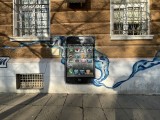
iPhone 12 Pro ultrawide cam, 12MP








iPhone 12 Pro Max ultrawide cam, 12MP
Moving on to zooming. The Pro and Pro Max has the same sensor for their telephoto snappers - a 12MP with 1.0µm pitch, but use different optics. The regular Pro offers 52mm f/2.0 OIS lens for 2x zoom, while the Pro Max has 65mm f/2.2 OIS lens for longer 2.5x zoom.
And the first thing you'd notice is the magnification difference, of course. It's not a jaw-dropping gap between 2x and 2.5x zoom, but you can see smaller details on objects that were impossible to be captured on the regular Pro.
Other than that, the photos appear to be identical in quality - they show excellent detail, colors, contrast and good dynamic range.
You can compare the untouched samples below and see for yourself. These also demonstrate pretty good the zoom difference, so they may help you decide whether you need the extra magnification or not.







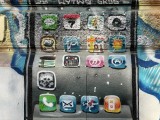
iPhone 12 Pro tele 2x camera, 12MP








iPhone 12 Pro Max tele 2.5x camera, 12MP
Let's see some low-light photos now. Here the benefits of the new sensor and stabilization begin to show.
The first obvious difference we observed on the main camera is speed. The iPhone 12 Pro usually opts for 2s or 3s exposures for its Night Mode, while the 12 Pro Max is always locked at 1s due to its ability to capture more light with its larger sensor. So, the faster the Night Mode photos is taken, the lesser chance for blurred people and cars. Also, the faster speed also helps for less noise and sometimes this could even return a bit more detail.
Here, you can see the difference in the noise levels between the Pro (2s) and Pro Max (1s).
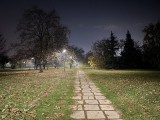
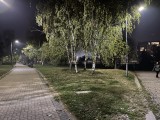
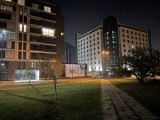





iPhone 12 Pro main cam (NM auto), 12MP








iPhone 12 Pro Max main cam (NM auto), 12MP
We shot the same scenes without Night Mode, too. The photos once again appear to be identical in quality - a bit darker and noisier than the Night Mode offers, and some highlights are blown.
Some further pixel peeping shows that the larger sensor on the 12 Pro Max sometimes allows the phone to drop the ISO - 5,000 on Pro and 4,000 on Max or 1,000 on Pro and 800 on Max. While the photos appear similar, thanks to the lower ISO setting, the noise levels on the 12 Pro Max are a bit lower.
We had to go a couple of times through these photos and we'd say the difference is indeed fractional.
Until Apple ProRAW becomes available and professionals become utilizing it, they will hardly find any differences between the two cameras. The better stabilization and the larger sensor will beat the Pro's main cam when taking a single frame as they will allow for longer shutter speeds and/or lower ISO. But when taking multiple photos, they get stacked and then processed and processed, and as you can see - there is no difference in the end.
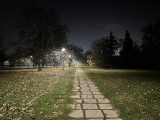

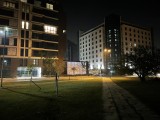



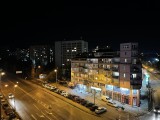

iPhone 12 Pro main cam (NM off), 12MP








iPhone 12 Pro Max main cam (NM off), 12MP
For the sake of this comparison, we also shot some ultrawide photos. We didn't make any crops as those are expectedly indistinguishable. You can compare them with our integrated tool, of course.

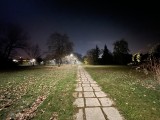
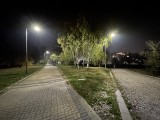





iPhone 12 Pro ultrawide cam (auto), 12MP








iPhone 12 Pro Max ultrawide cam (auto), 12MP
Let's look at some night photos from the telephoto snappers, too. The 12 Pro Max obviously offers longer zoom. It also has a darker optics f/2.2 vs f/2.0 on the 12 Pro.
The iPhone 12 Pro Max saves a bit darker photos, expectedly, but it has more aggressive noise reduction. Indeed, its zoomed photos demonstrate lower noise, but some fine detail was also smeared with that noise and is gone. It's the usual tradeoff.
Of course, those zoom camera don't always trigger - it depends on the available light. If the night mode icon pops up, this means the iPhones are going to zoom digitally instead.


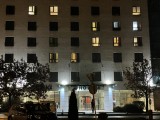

iPhone 12 Pro tele 2x cam, 12MP
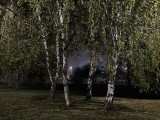
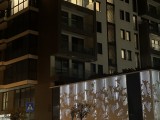
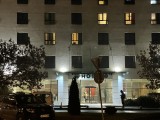

iPhone 12 Pro Max tele 2.5x cam, 12MP
Finally, we wanted to see if there is a difference in the highly proclaimed Night Mode for Portraits. Both phones turned out to be capable shooters for such scenes, but let's see them side by side now.
Both 12 Pro models shoot Night Mode Portraits with their main camera and the one on the 12 Pro Max seems to be saving the better ones. There is more detail, less noise, and the chance of blur is definitely lower thanks to the new type of stabilization. It also chooses 1s or maximum 2s exposures, whereas the regular Pro always opts for 2s or 3s exposures.
You can compare the samples side by side here.




iPhone 12 Pro Portraits with Night Mode




iPhone 12 Pro Max Portraits with Night Mode
Video comparison
It's time to look through some videos, shall we?
First, we shot two daylight videos at 4K@30fps with the main camera and they appear to be identical. Everything looks the same - detail, contrast, dynamic range and noise. The detail isn't impressive, but the rest is excellent.
Then we found out that the grass is a bit more developed on the Pro Max than the regular Pro. It's a minor difference and it's a blink and you miss it thing, but it's there. It's still not a good-looking grass, so don't open your wallets just yet.
Here, you can compare screen grabs from the 4K footage on both phones.


iPhone 12 Pro • iPhone 12 Pro Max
And here are the two videos.
The new IBIS stabilization on the iPhone 12 Pro Max should provide an edge over the regular Pro when shooting videos while walking or panning. See, the IBIS counters for rotational shake in addition to the regular X and Y axis movements and in theory should be offering less tilt of the horizon when making such motions.
Well, we tried our best, but both phones seem to be equally great to counter whatever we did. First, we walked a bit and tilted the phones while panning. Then we went a bit more aggressive in the second part of the video as we rotated the phones around the axis that's perpendicular of their plane. And yet, whether it is OIS+EIS or IBIS+EIS - both did a fantastic job!
This wasn't enough for us, so we did more! We captured side-by-side 4K videos while walking on both 30fps and 60fps. And guess what - these are amazing on both iPhones.
Then we captured the same videos while running. And Apple once again wowed us with its proficient stabilization across both phones. Nice!
Finally, we took some low-light videos only to find those similar, too. It took us some eye-popping pixel peeping and the only hint of a difference we find in these shadows where the 12 Pro Max exposes a tiny bit more detail.
Here, you can compare screen grabs from the 4K footage on both phones - they indeed are similar in quality.


iPhone 12 Pro • iPhone 12 Pro Max
And here are the two videos.
Conclusion: Both the iPhone 12 Pro and 12 Pro Max are excellent shooters and they often offer indistinguishable photos and videos no matter the hardware specs. The most notable difference is the longer zoom on the 12 Pro Max model, which also saves less noisy but also less detailed low light photos by the telephoto camera.
The faster exposure time in Night Mode lead to a bit more captured detail and less noise in certain scenarios like Portraits. Blurred cars and people are not as occasional as on the 12 Pro Max, too.
You could benefit from the 12 Pro Max hardware in RAW, but you need to be up for the RAW editing challenge. For everything else - the only real difference you'd see between those two phones is in the magnification level.
Alternatives
This year, you can choose between three different iPhone sizes, and we believe this will continue to be the case in the years to come. The iPhone 12 mini and iPhone 12 will successfully cater to anyone who needs a compact flagship. This has allowed the 12 Pro Max to grow bigger and better without any holdbacks.

Indeed, this year, along with the new design with better materials, the new 12 Pro Max model brings an even larger screen. Its enormous size has allowed Apple to fit a better camera as well - the industry's first-ever sensor-shift stabilization and for the first time ever on an iPhone - a longer, 65mm zoom lens.
If the Pro Max's size is of any concern, the more reasonably-sized iPhone 12 Pro is literally the same phone, just smaller. Yes, we are well aware of the camera differences, yet our direct shootout proved that those won't really matter to the mainstream user as both phones deliver similar quality. So, if you want a triple camera but on a smaller iPhone, the 12 Pro is all you need.
The normal iPhone 12 will give you a lightweight body with all the Pro's power and screen without the telephoto camera and the LiDAR scanner. If you are not into AR apps, the lack of LiDAR won't matter to you. As for the zoom camera - only you can decide.
Apple has this bad habit of making all previous-gen iPhones disappear from the market within a week of its latest premiere, and the iPhone 11 Pro models have suffered the same fate. But if you already own an iPhone 11 Pro Max, there is really no reason to upgrade. It's still quite recent, and you don't really need the LiDAR or the new glossy frame, which looks amazing only on the showroom floor. .
There is one Android phone that comes to mind when thinking in Max size, and that's the Galaxy Note20 Ultra 5G. It encompasses the best of everything Samsung has to offer. The Ultra has an even larger 6.9" OLED with higher resolution and a much smaller cutout. It also provides enormous processing power and has a rather unique triple camera with a 108MP primary, a 12MP 5x telephoto, and a 12MP ultrawide shooter. The Note packs an S-Pen that has become a fan-favorite feature for many. The Ultra is a powerful mini-tablet in your pocket, and if you are not invested much in Apple's ecosystem, you may want to give it a try.

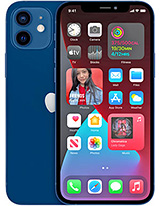
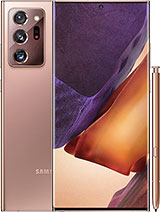
Apple iPhone 12 Pro • Apple iPhone 12 • Samsung Galaxy Note20 Ultra 5G
The verdict
The iPhone 12 Pro Max is Apple's mightiest iPhone on the market today. It employs the most massive iPhone screen ever. It has every new feature the company has come up with, and it's wrapped in a premium body with a bold new design that brings a dash of nostalgia. Heck, even its outrageous price tag is a selling point for many potential customers.
The 12 Pro Max is not without its flaws. On the contrary - it's doesn't even bring enough worthy upgrades over the 11 Pro Max to justify a switch. Not only that, but they are cutting back some features and deliberately omitting others. No charger, no headphones, same camera quality generation after generation, no high refresh rate screen when everyone else has one, and no under-display fingerprint reader when everybody is forced to wear a mask.
Apple is certainly not a company to go with the trends. On the opposite, their success in doing things differently has turned them into a trend-setter. For any other company, any of these decisions would have led to a severe backlash. Yet, Apple's mobile business is doing better than ever.
They've earned a special place in the customer's hearts and minds by coming up with consistently polished products with great after-sales service, and of course, by supplementing all this effort with great marketing.

The iPhone 12 Pro Max is a product of the same great recipe for success. So without a doubt, millions of customers have already bought one, and millions more will get theirs in the year ahead.
Do we recommend getting it? Certainly, if you are after the large screen and you have an older iPhone. If you already have a recent device like the iPhone 11 Pro or Pro Max, there is really not much sense in upgrading.
Don't miss our iPhone 12 upgrader's guide to see how good of an upgrade would the new iPhones make to your older iPhone.
Pros
- Sumptuous design with jewelry-like attention to detail, durable and water-resistant
- Excellent large OLED screen, very bright
- Loud stereo speakers, outstanding audio quality
- The fastest smartphone chip on the planet, 5G, too
- Dependable battery life, fast charging
- Apple iOS 14 is fast and easy to use, 5 years of guaranteed major updates
- Very good photo and video quality across the board, day and night
- LiDAR Scanner has varied applications and use cases (albeit quite niche)
- MagSafe is a promising accessory concept
Cons
- No charger or headphones in the box
- No high refresh rate screen
- iOS needs better file management
- We miss TouchID as FaceID does not work with a mask on
- The new camera offers the same quality as the old one
- Few meaningful upgrades over iPhone 11 Pro Max and even fewer over iPhone 12 Pro












































































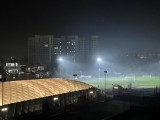
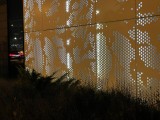

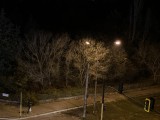






























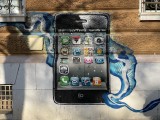

0 Response to "Apple iPhone 12 Pro Max review"
Post a Comment